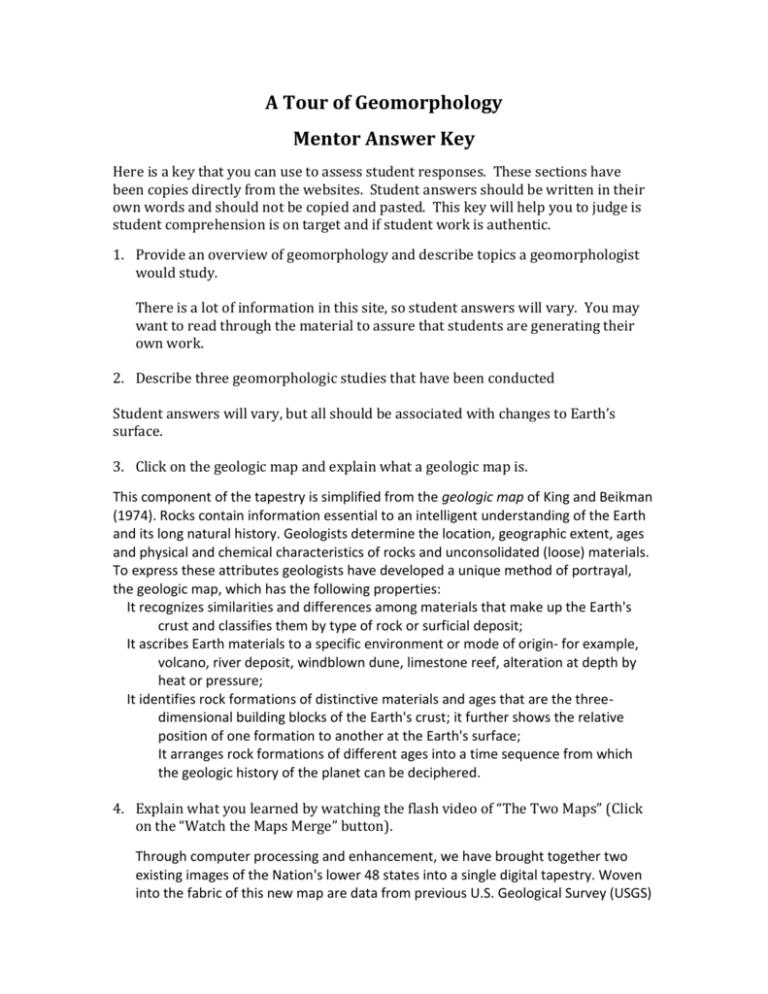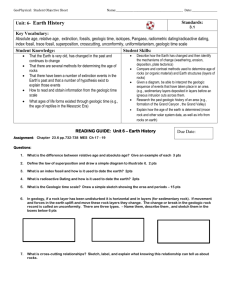A Tour of Geomorphology Mentor Answer Key Here is a key that you
advertisement

A Tour of Geomorphology Mentor Answer Key Here is a key that you can use to assess student responses. These sections have been copies directly from the websites. Student answers should be written in their own words and should not be copied and pasted. This key will help you to judge is student comprehension is on target and if student work is authentic. 1. Provide an overview of geomorphology and describe topics a geomorphologist would study. There is a lot of information in this site, so student answers will vary. You may want to read through the material to assure that students are generating their own work. 2. Describe three geomorphologic studies that have been conducted Student answers will vary, but all should be associated with changes to Earth’s surface. 3. Click on the geologic map and explain what a geologic map is. This component of the tapestry is simplified from the geologic map of King and Beikman (1974). Rocks contain information essential to an intelligent understanding of the Earth and its long natural history. Geologists determine the location, geographic extent, ages and physical and chemical characteristics of rocks and unconsolidated (loose) materials. To express these attributes geologists have developed a unique method of portrayal, the geologic map, which has the following properties: It recognizes similarities and differences among materials that make up the Earth's crust and classifies them by type of rock or surficial deposit; It ascribes Earth materials to a specific environment or mode of origin- for example, volcano, river deposit, windblown dune, limestone reef, alteration at depth by heat or pressure; It identifies rock formations of distinctive materials and ages that are the threedimensional building blocks of the Earth's crust; it further shows the relative position of one formation to another at the Earth's surface; It arranges rock formations of different ages into a time sequence from which the geologic history of the planet can be deciphered. 4. Explain what you learned by watching the flash video of “The Two Maps” (Click on the “Watch the Maps Merge” button). Through computer processing and enhancement, we have brought together two existing images of the Nation's lower 48 states into a single digital tapestry. Woven into the fabric of this new map are data from previous U.S. Geological Survey (USGS) maps that depict the topography and geology of the United States. The resulting composite is the most detailed and accurate portrait of the U.S. land surface and the ages of its underlying rock formations yet displayed in the same image. The new map resembles traditional 3-D perspective drawings of landscapes with the addition of a fourth dimension, geologic time, which is shown in color. In mutually enhancing the landscape and its underlying temporal structure, this digital tapestry outlines the geologic story of continental collision and break-up, mountain-building, river erosion and deposition, ice-cap glaciation, volcanism, and other events and processes that have shaped the region over the last 2.6 billion years. 5. Click on the topographic map and explain what a topographic map is. This component of the tapestry is the digital shaded-relief image, created by Thelin and Pike (1991), that shows the shape of the land surface by variations in brightness. The degree of light and dark artificially mimics the intensity of the Sun's light on different types of topography. This technique, called chiaroscuro, dates back some 400 years to sketches of the Tuscan landscape by Leonardo da Vinci. Because manual (artistic) portrayals of terrain can practicably show only small areas both accurately and in detail, the technique has been automated by the computer to cover large regions. The resulting digital shaded-relief map of the lower 48 states succeeded the unique, if less accurate, hand-drawn landform map by master cartographer Erwin Raisz. Landscape features contain many of the clues needed to understand the Earth and the agents that have shaped it. Finding and decoding these clues enables scientists to learn more about natural hazards, the events of Earth history, and resources of land, water, energy, and minerals. Many methods of landscape portrayal are used to view surface features, but shaded-relief imaging by computer is unique in the following respects: It provides fine-scale detail over a wide area, a combination not possible in other techniques of illustration; It shows terrain accurately and in its true complexity, two properties commonly lost in sketches and diagrams of large areas; Unlike mosaics of aerial photos and radar images, the view -- limited only by extent of the digital data set -- is continuous across the country; Relief shading is free of distortion and the vegetation and cultural features that conceal topographic form on satellite images. 4. Click on the “Description of Features” link and select #14 and explain what you are looking at. The Fall Line is a low east-facing cliff paralleling the Atlantic coastline from New Jersey to the Carolinas. It separates hard Paleozoic metamorphic rocks of the Appalachian Piedmont to the west from the softer, gently dipping Mesozoic and Tertiary sedimentary rocks of the Coastal Plain. This erosional scarp, the site of many waterfalls, hosted flume- and water-wheel-powered industries in colonial times and thus helped determine the location of such major cities as Philadelphia, Baltimore, Washington, and Richmond. 5. Click on the “Metamorphic Rocks” link. What did you learn about metamorphic rock layers? Where are these rock layers found? Sometimes it is difficult to tell how old a rock is. This is especially true of metamorphic rocks. Metamorphic rocks are rocks that have undergone a change, usually due to high temperatures and/or pressures. The heat and pressure that they have been subjected to often "resets" their geologic clocks to the time of their metamorphism. These rock layers are found in a south-west to north-east band along the east coast of the United States. 6. Click on the link “about the Cambrian and Ordivician Periods”. What did you learn about these rock layers? Where are they found? The rocks highlighted here are some of the oldest in the United States. They formed in the Cambrian Period, between 560 and 504 million years ago, and the Ordovician Period, between 504 and 438 million years ago. The Cambrian Period is the earliest division of the Paleozoic Era, followed by the Ordovician period. During the Cambrian, life began to bloom in the Earth's oceans. By the Ordovician, marine life was very diverse, with creatures like primitive fish, corals, and trilobites. These rock layers are found throughout the United States, but are concentrated in a band running south-west to north-east along the eastern coast of the United States. 7. Click on the link “about the Upper Tertiary Period”. What did you learn about these rock layers? Where are they found? The rocks highlighted here are some of the youngest in the United States. They formed in the late Tertiary Period, between 38 and 1.6 million years ago. The Tertiary Period is subdivided into epochs. The youngest Tertiary epochs, the Miocene, Pliocene, and Oligocene are shown here. During this time, sediments eroded from the uplifting Rocky Mountains were being deposited in huge alluvial fans that formed the Great Plains. In the eastern U.S., sediments were also being deposited, forming the Coastal Plain. In the west, subduction led to the formation of a chain of volcanic mountains called the Cascade Range. They are found at several locations out west and in a narrow band along the coastline from Texas to New York.







